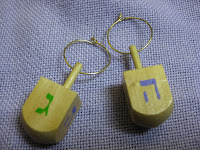 |
| Wire Gauge |
Yesterday we explained How to
Make an Ear Cuff. In that entry, we included a link to
General Tools 20 American Standard Wire Round Gage
. One of our readers wrote in and aksed how and why does she need a wire gauge. Fair question.
If you love making
jewelry like we do, you likely collected a variety of different size wire from different projects. Some of the wire is no longer in the original package and it may not always be obvious what wire is what size. To identify the gauge of mystery wire we use the Brown and Sharpe wire gauge (also called an American wire gauge). Using a wire gauge, you can measure your mystery wire and determine its gauge.
A little background
The Brown and Sharpe wire gauge (aka the
American Standard wire gauge) is a standardized system developed in the United States in about 1857 to measure the diameter of round, solid, nonferrous wire. The cross-sectional area of wire gauge is a very important for determining the electrical current-carrying capacity of wire. In the jewelry industry, the B and S standard is used to measure all shapes of wire and sheet stock. The tool is very easy to use and will take the mystery out of your wire collection.
Step 1
 |
| Slide Wire into Slot |
Slide the mystery wire into the slot that looks like it is the size of the wire. If that slot is not correct, try again. The wire should fit snug, but you should not need to force the wire for it to fit.
Step 2
Look at the number on the slot. In the photo at left, the mystery wire measures as 18 gauge. Mystery solved! The
American Standard Wire Round Gage
tool measures wire ranging from 0 to 30 gauge. Although it is counter-intuitive, using the scale on the gauge, "O" is the largest, thickest wire. "30" is the smallest, thinnest wire.
Step 3
Use your tool to select the correct wire for your project. There are no right or wrong sizes of wire to be used in jewelry making. These are typical sizes of wire used in jewelry making projects:
Ear wires: 21 or 20 gauge
Head pins: 22 to 18 gauge
Wire wrapping briolettes: 22-26 gauge, depending on hole size
Wire wrapping pearls: 22-26 gauge, depending on hole size
Wire wrapping lamp work beads: 18-16 gauge, depending on hole size
Pendants: 18 to 20 gauge
Bangles: 14 gauge
Neck rings: 14 gauge
Ring shanks: 10-12 gauge
Tips and Warnings
Always wear eye protection when cutting wire.
A different standard is used to measure wire in the United Kingdom: the Imperial Standard Wire Gauge (aka the British legal standard).
In other parts of the world, the diameter of wire is measured using the metric system in millimeters.
Further Reading
Tutorials by GeltDesigns
Complete Metalsmith: Professional Edition Jewelry Studio: Wire Wrapping
Jewelry Studio: Wire Wrapping Wirework w/DVD: An Illustrated Guide to the Art of Wire Wrapping
Wirework w/DVD: An Illustrated Guide to the Art of Wire Wrapping
 Contemporary Wire Wrapped Jewelry (Jewelry Crafts)
Contemporary Wire Wrapped Jewelry (Jewelry Crafts) Wire Style: 50 Unique Jewelry Designs
Wire Style: 50 Unique Jewelry Designs
 Inspired Wire: Learn to Twist, Jig, Bend, Hammer, and Wrap for the Prettiest Jewelry Ever
Inspired Wire: Learn to Twist, Jig, Bend, Hammer, and Wrap for the Prettiest Jewelry Ever Bead on a Wire: Making Handcrafted Wire and Beaded Jewelry
Bead on a Wire: Making Handcrafted Wire and Beaded Jewelry Creative Wire Jewelry
Creative Wire Jewelry Creative Wire Jewelry
Creative Wire Jewelry

 Mystery Bits
Mystery Bits







 elry for the ear that does not require piercing. The ear cuff hugs the outer portion of the ear. Ear cuffs do not require the use of findings-- pierced or clips.
elry for the ear that does not require piercing. The ear cuff hugs the outer portion of the ear. Ear cuffs do not require the use of findings-- pierced or clips.
 Step 5
Step 5 Step 6
Step 6
 during use.
during use.
